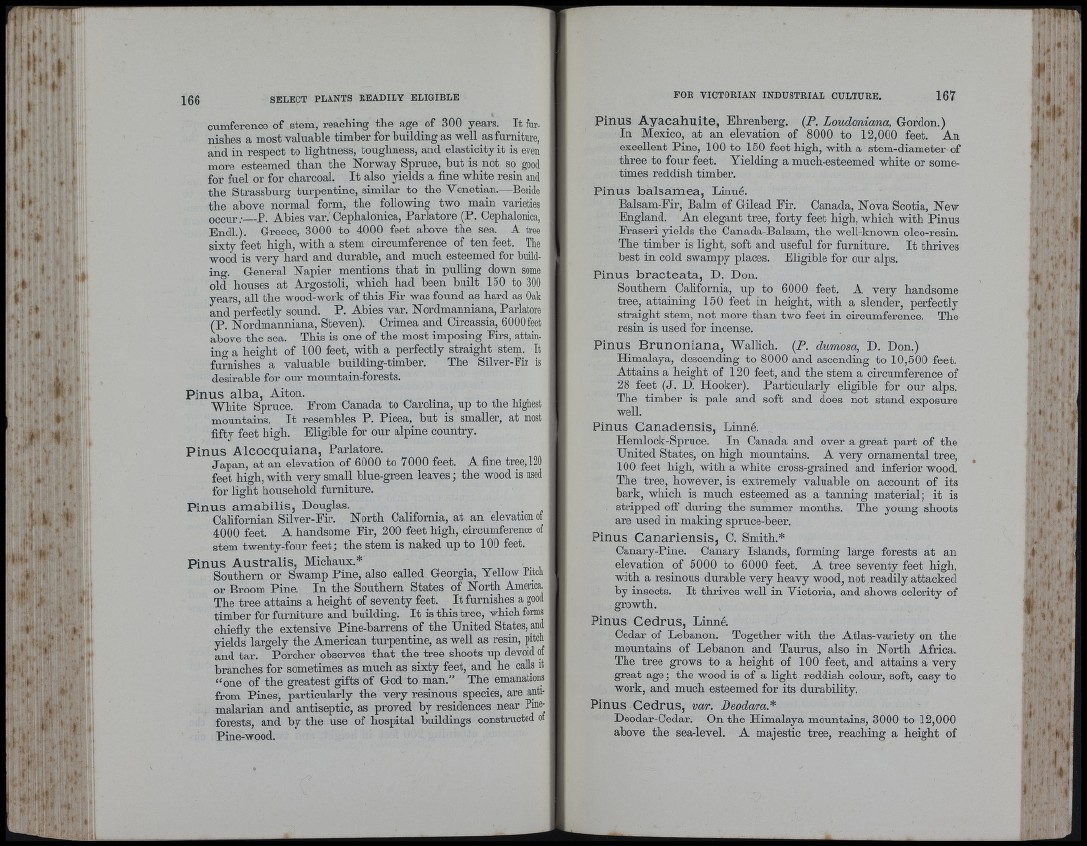
-
I":
ll •
cumference of stem, reaching the age of 300 years. It furnishes
a most valuable timber for building as well as furniture,
and in respect to lightness, toughness, and elasticity it is even
more esteemed than tbe Norway Spruce, but is not so good
for fuel or for charcoal. I t also yields a fine white resin and
tbe Strassburg turpentine, similar to the Venetian.—Beside
the above normal form, the following two main varieties
occur .• P. Abies var.' Cephalonica, Parlatore (P. Cephalonica,
Endl). Greece, 3000 to 4000 feet above the sea. A tree
sixty feet high, with a stem circumference of ten feet. The
wood is very hard and durable, and much esteemed for building.
General Napier mentions th a t in pulling down some
old bouses at Argostoli, wliicli had been built 150 to 300
years, all tbe wood-work of this Eir was found as hard as Oak
and perfectly sound. P. Abies var. Nordmanniana, Parlatore
(P. Nordmanniana, Steven). Crimea and Circassia, 6000 feet
above the sea. Tbis is one of tbe most imposing Firs, attaiii-
in» a height of 1 0 0 feet, with a perfectly straight stem. It
furnishes a valuable building-timber. Tbe Silver-Pir is
desirable for our mountain-forests.
Pinus alba, Aiton.
White Spruce. Erom Canada to Carolina, up to the highest
mountains. I t resembles P. Picea, but is smaller, at most
fifty feet high. Eligible for our alpine country.
Pinus Alcocquiana, Parlatore.
Japan, at an elevation of 6000 to 7000 feet. A fine tree, 120
feet high, with very small blue-green leaves; tbe wood is used
for light household furniture.
Pinus amabilis, Douglas.
Californian Silver-Eir. North California, at an elevation of
4000 feet. A handsome Fir, 200 feet high, circumference of
stem twenty-four feet; the stem is naked up to 1 0 0 feet.
Pinus Australis, Michaipc.*
Southern or Swamp Pine, also called Georgia, Yellow Pitch
or Broom Pine. In the Southern States of North America.
The tree attains a height of seventy feet. I t furnishes a good
timber for furniture and building. I t is tbis tree, which forms
chiefly the extensive Pine-barrens of tbe United States, and
yields largely the American turpentine, as well as resin, pitch
and tar. Porcher observes th a t the tree shoots up devoid of
branches for sometimes as much as sixty feet, and he calls it
“ one of the greatest gifts of God to man.” The emanation
from Pines, particularly the very resinous species, are anti-
malarian and antiseptic, as proved by residences near Pme
forests, and by the use of hospital buildings constructed ot
Pine-wood.
Pinus Ayacahuite, Ehrenberg. (P. Loudoniana, Gordon.)
In Mexico, at an elevation of 8000 to 12,000 feet. An
excellent Pine, 100 to 150 feet high, with a stem-diameter of
three to four feet. Yielding a much-esteemed white or sometimes
reddish timber.
Pinus balsamea, Linné.
Balsam-Eir, Balm of Gilead Eir. Canada, Nova Scotia, New
England. An elegant tree, forty feet bigb, which with Pinus
Eraseri yields the Canada-Balsam, the well-known oleo-resin.
The timber is light, soft and useful for furniture. I t thrives
best in cold swampy places. Eligible for our alps.
Pinus bracteata, D. Don.
Southern California, up to 6000 feet. A very handsome
tree, attaining 150 feet in height, with a slender, perfectly
straight stem, not more than two feet in circumference. The
resin is used for incense.
Pinus Brunoniana, Wallich. (P. dumosa, D. Don.)
Himalaya, descending to 8000 and ascending to 10,500 feet.
Attains a height of 120 feet, and the stem a circumference of
28 feet (J. D. Hooker). Particularly eligible for our alps.
The timber is pale and soft and does not stand exposure
well.
Pinus Canadensis, Linné.
Hemlock-Spruce. In Canada and over a great part of tbe
United States, on high mountains. A very ornamental tree,
1 0 0 feet bigb, with a white cross-grained and inferior wood.
The tree, however, is extremely valuable on account of its
bark, which is much esteemed as a tanning material; it is
stripped oif during the summer months. The young shoots
are used in making spruce-beer.
Pinus Canariensis, C. Smith.*
Canary-Pine. Canary Islands, forming large forests at an
elevation of 5000 to 6000 feet. A tree seventy feet high,
with a resinous durable very heavy wood, not readily attacked
by insects. I t thrives well in Yictoria, and shows celerity of
growth.
Pinus Cedrus, Linné.
Cedar of Lebanon. Together with the Atlas-variety on the
mountains of Lebanon and Taurus, also in North Africa.
Tbe tree grows to a height of 100 feet, and attains a very
great age; the wood is of a light reddish coloin-, soft, easy to
work, and much esteemed for its durability.
Pinus Cedrus, vmr. BeodaraJ
Deodar-Cedar. On the Himalaya mountains, 3000 to 12,000
above the sea-level. A majestic tree, reaching a height of